with独立结构精讲
- 格式:doc
- 大小:55.00 KB
- 文档页数:10
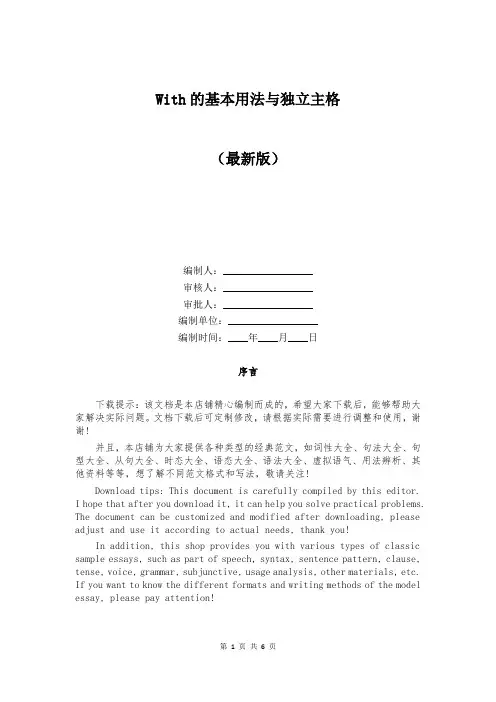
With的基本用法与独立主格(最新版)编制人:__________________审核人:__________________审批人:__________________编制单位:__________________编制时间:____年____月____日序言下载提示:该文档是本店铺精心编制而成的,希望大家下载后,能够帮助大家解决实际问题。
文档下载后可定制修改,请根据实际需要进行调整和使用,谢谢!并且,本店铺为大家提供各种类型的经典范文,如词性大全、句法大全、句型大全、从句大全、时态大全、语态大全、语法大全、虚拟语气、用法辨析、其他资料等等,想了解不同范文格式和写法,敬请关注!Download tips: This document is carefully compiled by this editor.I hope that after you download it, it can help you solve practical problems. The document can be customized and modified after downloading, please adjust and use it according to actual needs, thank you!In addition, this shop provides you with various types of classic sample essays, such as part of speech, syntax, sentence pattern, clause, tense, voice, grammar, subjunctive, usage analysis, other materials, etc. If you want to know the different formats and writing methods of the model essay, please pay attention!With的基本用法与独立主格with结构是许多英语复合结构中最常用的一种。
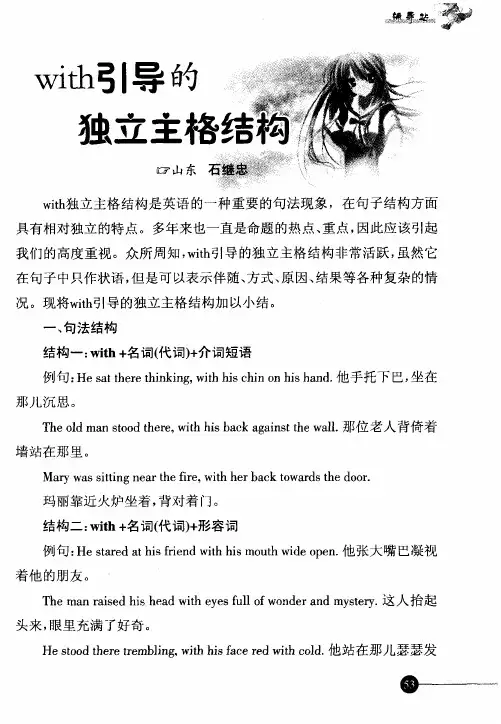
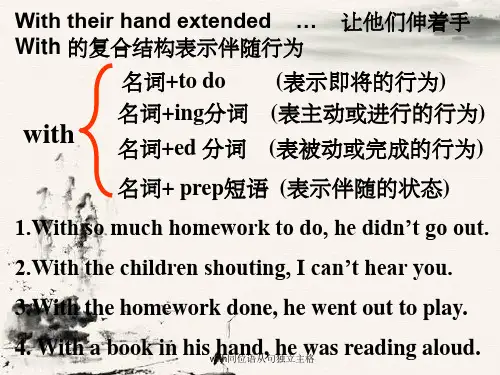
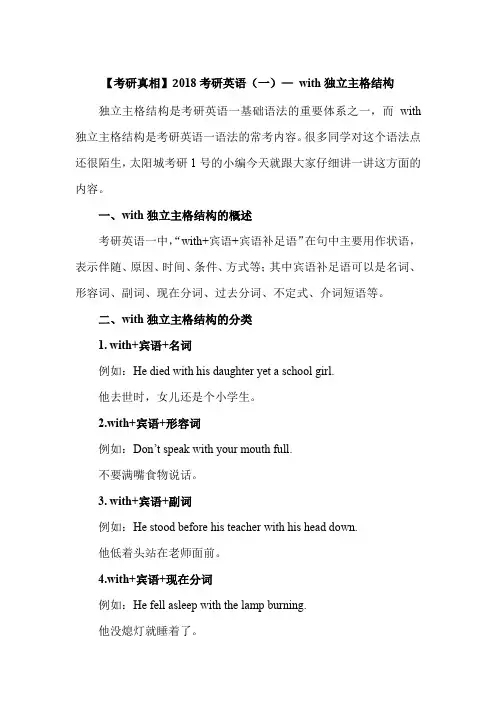
【考研真相】2018考研英语(一)—with独立主格结构独立主格结构是考研英语一基础语法的重要体系之一,而with 独立主格结构是考研英语一语法的常考内容。
很多同学对这个语法点还很陌生,太阳城考研1号的小编今天就跟大家仔细讲一讲这方面的内容。
一、with独立主格结构的概述考研英语一中,“with+宾语+宾语补足语”在句中主要用作状语,表示伴随、原因、时间、条件、方式等;其中宾语补足语可以是名词、形容词、副词、现在分词、过去分词、不定式、介词短语等。
二、with独立主格结构的分类1.with+宾语+名词例如:He died with his daughter yet a school girl.他去世时,女儿还是个小学生。
2.with+宾语+形容词例如:Don’t speak with your mouth full.不要满嘴食物说话。
3.with+宾语+副词例如:He stood before his teacher with his head down.他低着头站在老师面前。
4.with+宾语+现在分词例如:He fell asleep with the lamp burning.他没熄灯就睡着了。
5.with+宾语+过去分词例如:She sat there with his eyes closed.她闭目坐在那儿。
6.with+宾语+动词不定式例如:I can’t go out with all these clothes to wash.要洗这些衣服,我无法出去了。
7.with+宾语+介词短语例如:She said good bye with tears in her eyes.她含着眼泪说了声再见。
接下来我们一起来看一下with独立主格结构在考研英语一真题中出现的实例:(图片源自《考研真相》2009年考研英语(一)阅读理解Text3)如上图中所示“with the country entering a recession”和“(with)Japan at its pre-bubble peak”为and连接的with独立主格结构(分别为“with+宾语+现在分词”和“with+宾语+介词短语”)。
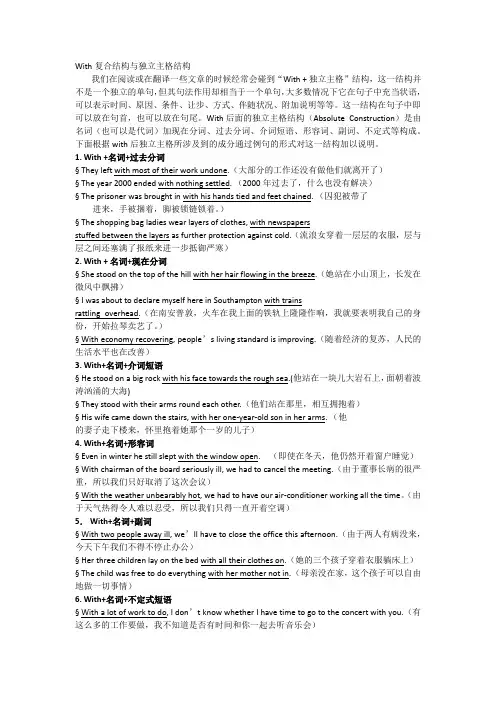
With复合结构与独立主格结构我们在阅读或在翻译一些文章的时候经常会碰到“With +独立主格”结构,这一结构并不是一个独立的单句,但其句法作用却相当于一个单句,大多数情况下它在句子中充当状语,可以表示时间、原因、条件、让步、方式、伴随状况、附加说明等等。
这一结构在句子中即可以放在句首,也可以放在句尾。
With后面的独立主格结构(Absolute Construction)是由名词(也可以是代词)加现在分词、过去分词、介词短语、形容词、副词、不定式等构成。
下面根据with后独立主格所涉及到的成分通过例句的形式对这一结构加以说明。
1.With +名词+过去分词§They left with most of their work undone.(大部分的工作还没有做他们就离开了)§The year 2000 ended with nothing settled.(2000年过去了,什么也没有解决)§The prisoner was brought in with his hands tied and feet chained.(囚犯被带了进来,手被捆着,脚被锁链锁着。
)§The shopping bag ladies wear layers of clothes,with newspapersstuffed between the layers as further protection against cold.(流浪女穿着一层层的衣服,层与层之间还塞满了报纸来进一步抵御严寒)2.With +名词+现在分词§She stood on the top of the hill with her hair flowing in the breeze.(她站在小山顶上,长发在微风中飘拂)§I was about to declare myself here in Southampton with trainsrattling overhead.(在南安普敦,火车在我上面的铁轨上隆隆作响,我就要表明我自己的身份,开始拉琴卖艺了。
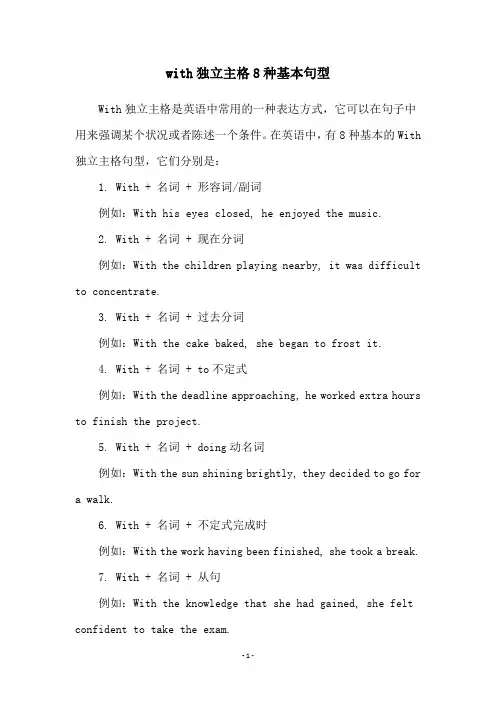
with独立主格8种基本句型With独立主格是英语中常用的一种表达方式,它可以在句子中用来强调某个状况或者陈述一个条件。
在英语中,有8种基本的With 独立主格句型,它们分别是:1. With + 名词 + 形容词/副词例如:With his eyes closed, he enjoyed the music.2. With + 名词 + 现在分词例如:With the children playing nearby, it was difficult to concentrate.3. With + 名词 + 过去分词例如:With the cake baked, she began to frost it.4. With + 名词 + to不定式例如:With the deadline approaching, he worked extra hours to finish the project.5. With + 名词 + doing动名词例如:With the sun shining brightly, they decided to go fora walk.6. With + 名词 + 不定式完成时例如:With the work having been finished, she took a break.7. With + 名词 + 从句例如:With the knowledge that she had gained, she felt confident to take the exam.8. With + 名词 + 介词短语例如:With his hand on her shoulder, he reassured her that everything would be alright.这8种With独立主格句型在英语中使用非常广泛,可以用来表达各种不同的情境和意思。
学会运用它们,能够让我们的英语表达更加地流畅自然。
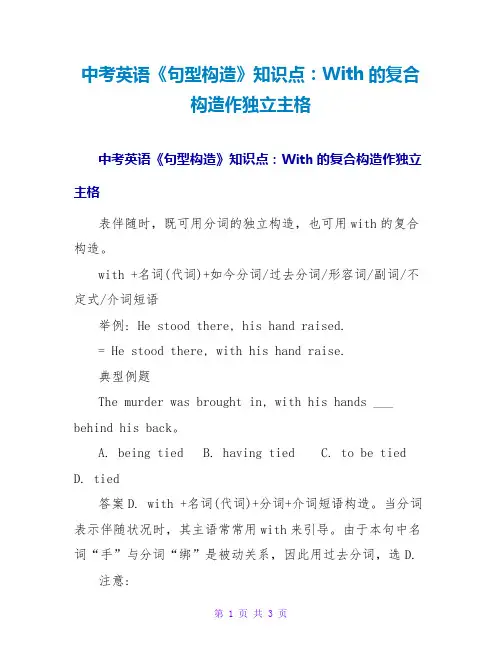
中考英语《句型构造》知识点:With的复合构造作独立主格中考英语《句型构造》知识点:With的复合构造作独立主格表伴随时,既可用分词的独立构造,也可用with的复合构造。
with +名词(代词)+如今分词/过去分词/形容词/副词/不定式/介词短语举例: He stood there, his hand raised.= He stood there, with his hand raise.典型例题The murder was brought in, with his hands ___ behind his back。
A. being tiedB. having tiedC. to be tiedD. tied答案D. with +名词(代词)+分词+介词短语构造。
当分词表示伴随状况时,其主语常常用with来引导。
由于本句中名词“手”与分词“绑”是被动关系,因此用过去分词,选D.注意:1) 独立主格构造使用介词的问题:当介词是in时,其前后的两个名词均不加任何成分(如物主代词或冠词),也不用复数。
但 with 的复合构造不受此限制A robber burst into the room, knife in hand.( hand前不能加his)。
2) 当表人体部位的词做逻辑主语时,及物动词用如今分词,不及物动词用过去分词。
He lay there, his teeth set, his hand clenched, his eyes looking straight up.典型例题:Weather___, we'll go out for a walk.A permittedB permittingC permitsD for permitting答案B. 此题中没有连词,它不是复合句,也不是并列句。
句中使用了逗号,且we 小写,可知其不是两个简单句。
可以这样使用的只有独立主格或with的复合构造。
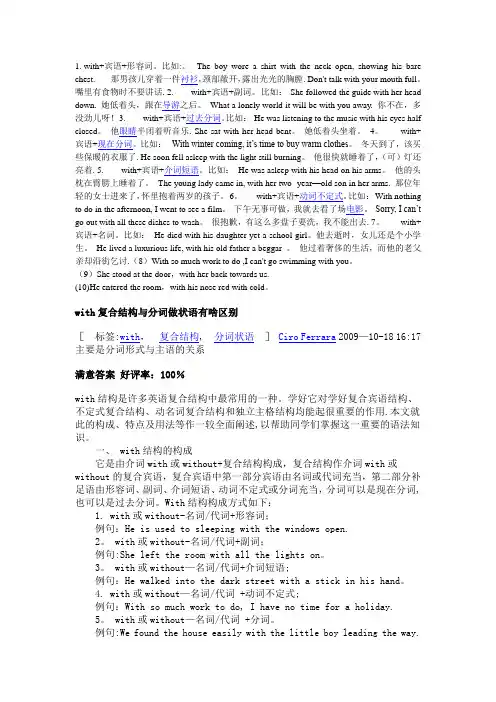
1. with+宾语+形容词。
比如:。
The boy wore a shirt with the neck open, showing his bare chest. 那男孩儿穿着一件衬衫,颈部敞开,露出光光的胸膛. Don't talk with your mouth full。
嘴里有食物时不要讲话.2. with+宾语+副词。
比如: She followed the guide with her head down. 她低着头,跟在导游之后。
What a lonely world it will be with you away. 你不在,多没劲儿呀!3. with+宾语+过去分词。
比如: He was listening to the music with his eyes half closed。
他眼睛半闭着听音乐. She sat with her head bent。
她低着头坐着。
4。
with+宾语+现在分词。
比如:With winter coming, it’s time to buy warm clothes。
冬天到了,该买些保暖的衣服了. He soon fell asleep with the light still burning。
他很快就睡着了,(可)灯还亮着. 5. with+宾语+介词短语。
比如:He was asleep with his head on his arms。
他的头枕在臂膀上睡着了。
The young lady came in, with her two- year—old son in her arms. 那位年轻的女士进来了,怀里抱着两岁的孩子。
6。
with+宾语+动词不定式。
比如:With nothing to do in the afternoon, I went to see a film。
下午无事可做,我就去看了场电影。
Sorry, I can’t go out with all these dishes to wash。
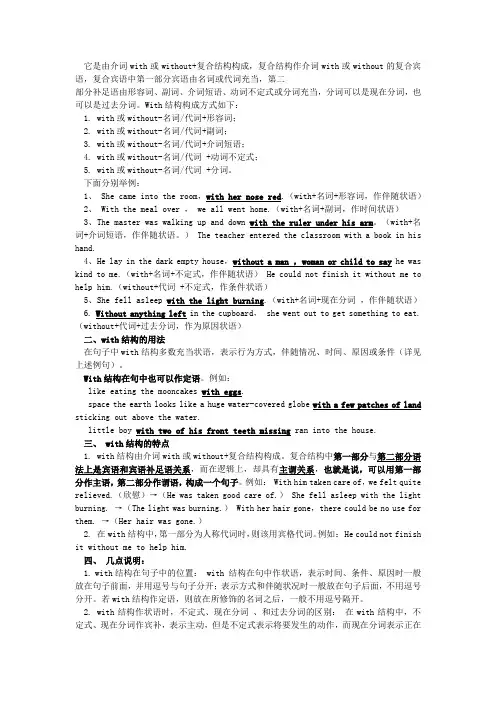
它是由介词with或without+复合结构构成,复合结构作介词with或without的复合宾语,复合宾语中第一部分宾语由名词或代词充当,第二部分补足语由形容词、副词、介词短语、动词不定式或分词充当,分词可以是现在分词,也可以是过去分词。
With结构构成方式如下:1. with或without-名词/代词+形容词;2. with或without-名词/代词+副词;3. with或without-名词/代词+介词短语;4. with或without-名词/代词 +动词不定式;5. with或without-名词/代词 +分词。
下面分别举例:1、 She came into the room,with her nose red.(with+名词+形容词,作伴随状语)2、 With the meal over , we all went home.(with+名词+副词,作时间状语)3、The master was walking up and down with the ruler under his arm。
(with+名词+介词短语,作伴随状语。
) The teacher entered the classroom with a book in his hand.4、He lay in the dark empty house,without a man ,woman or child to say he was kind to me.(with+名词+不定式,作伴随状语) He could not finish it without me to help him.(without+代词 +不定式,作条件状语)5、She fell asleep with the light burning.(with+名词+现在分词,作伴随状语)6. Without anything left in the cupboard, she went out to get something to eat.(without+代词+过去分词,作为原因状语)二、with结构的用法在句子中with结构多数充当状语,表示行为方式,伴随情况、时间、原因或条件(详见上述例句)。
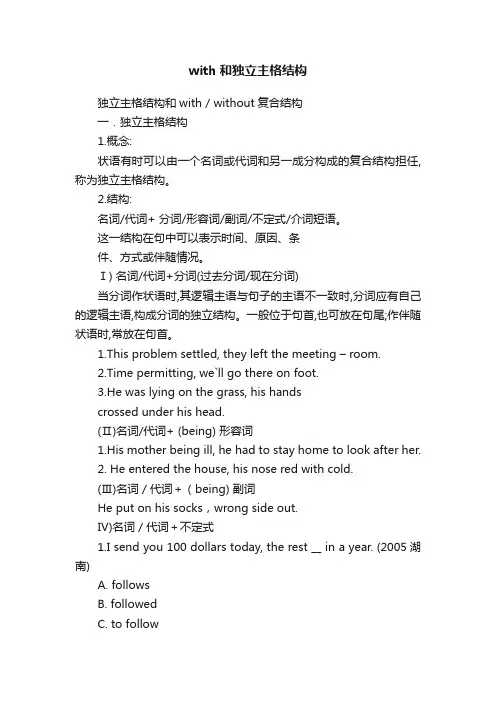
with和独立主格结构独立主格结构和with / without复合结构一.独立主格结构1.概念:状语有时可以由一个名词或代词和另一成分构成的复合结构担任,称为独立主格结构。
2.结构:名词/代词+ 分词/形容词/副词/不定式/介词短语。
这一结构在句中可以表示时间、原因、条件、方式或伴随情况。
Ⅰ) 名词/代词+分词(过去分词/现在分词)当分词作状语时,其逻辑主语与句子的主语不一致时,分词应有自己的逻辑主语,构成分词的独立结构。
一般位于句首,也可放在句尾;作伴随状语时,常放在句首。
1.This problem settled, they left the meeting – room.2.Time permitting, we`ll go there on foot.3.He was lying on the grass, his handscrossed under his head.(Ⅱ)名词/代词+ (being) 形容词1.His mother being ill, he had to stay home to look after her.2. He entered the house, his nose red with cold.(Ⅲ)名词/代词+(being) 副词He put on his socks,wrong side out.Ⅳ)名词/代词+不定式1.I send you 100 dollars today, the rest __ in a year. (2005湖南)A. followsB. followedC. to followD. being followed2. Here are the first two volumes, the third one to come out.Ⅴ)名词/代词+介词短语在这一结构中,如果逻辑主语与介词短语中的名词都是单数名词,这些名词前习惯不用冠词。
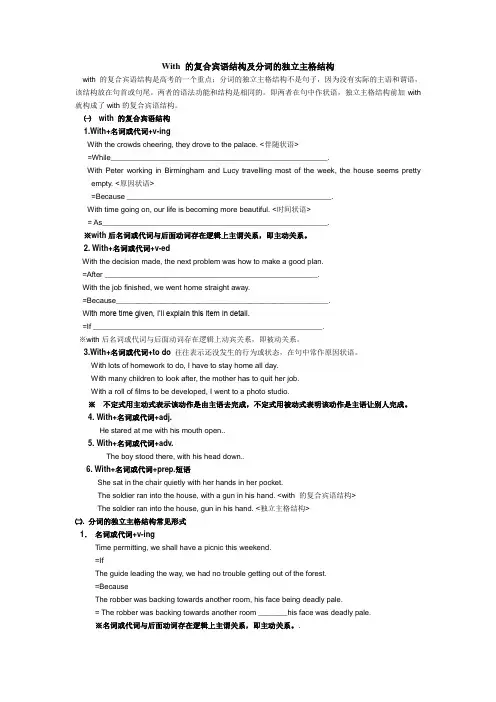
With 的复合宾语结构及分词的独立主格结构with 的复合宾语结构是高考的一个重点;分词的独立主格结构不是句子,因为没有实际的主语和谓语,该结构放在句首或句尾。
两者的语法功能和结构是相同的。
即两者在句中作状语,独立主格结构前加with 就构成了with的复合宾语结构。
㈠with 的复合宾语结构1.With+名词或代词+v-ingWith the crowds cheering, they drove to the palace. <伴随状语>=While____________________________________________________.With Peter working in Birmingham and Lucy travelling most of the week, the house seems pretty empty. <原因状语>=Because _________________________________________________.With time going on, our life is becoming more beautiful. <时间状语>= As______________________________________________________.※with后名词或代词与后面动词存在逻辑上主谓关系,即主动关系。
2. With+名词或代词+v-edWith the decision made, the next problem was how to make a good plan.=After ___________________________________________________.With the job finished, we went home straight away.=Because___________________________________________________.With more time given, I’ll explain this item in detail.=If _______________________________________________________.※with后名词或代词与后面动词存在逻辑上动宾关系,即被动关系。
with引导的独立主格结构英语中,with引导的独立主格结构很富有表现力,在句子中作状语,表示伴随、方式、原因、结果等。
它不是句子而是短语,其结构为:with+名词/代词+介词短语/形容词/副词/ 名词/非谓语动词。
公式:with+宾语+宾补(with复合结构)。
现将with引导的独立主格结构作一小结。
1. with +名词(代词)+介词短语He sat there thinking, with his chin on his hand.他手托下巴,坐在那儿沉思。
The old man stood there, with his back against the wall.那位老人背倚着墙站在那里。
Mary was sitting near the fire, with her back towards the door.玛丽靠近火炉坐着,背对着门。
2. with +名词(代词)+形容词He stared at his friend with his mouth wide open.他张大嘴巴凝视着他的朋友。
The man raised his head with eyes full of wonder and mystery.这人抬起头来,眼里充满了好奇。
He stood there trembling, with his face red with cold.他站在那儿瑟瑟发抖,脸都冻红了。
3. with +名词(代词)+副词With production up by 60%, the company has had another excellent year.产量上升了60%, 公司又是一个好年景。
The stupid Emperor walked in the procession with nothing on.这位愚蠢的皇帝一丝不挂地行进在游行队伍中。
The naughty boy stood before his teacher with his head down.这个淘气的男孩低着头站在老师面前。
with(without)复合短语和独立主格结构的区别一、 with结构的构成它是由介词with或without+复合结构构成,复合结构作介词with或without的复合宾语,复合宾语中第一部分宾语由名词或代词充当,第二部分补足语由形容词、副词、介词短语、动词不定式或分词充当,分词可以是现在分词,也可以是过去分词。
With结构构成方式如下:1. with或without-名词/代词+形容词;2. with或without-名词/代词+副词;3. with或without-名词/代词+介词短语;4. with或without-名词/代词 +动词不定式;5. with或without-名词/代词 +分词。
下面分别举例:1、 She came into the room,with her nose red.(with+名词+形容词,作伴随状语)2、 With the meal over , we all went home.(with+名词+副词,作时间状语)3、The master was walking up and down with the ruler under his arm。
(with+名词+介词短语,作伴随状语。
)The teacher entered the classroom with a book in his hand.4、He lay in the dark empty house,without a man ,woman or child to say he was kind to me.(with+名词+不定式,作伴随状语) He could not finish it without me to help him.(without+代词 +不定式,作条件状语)5、She fell asleep with the light burning.(with+名词+现在分词,作伴随状语)6. Without anything left in the cupboard, she went out to get something to eat.(without+代词+过去分词,作为原因状语)二、with结构的用法在句子中with结构多数充当状语,表示行为方式,伴随情况、时间、原因或条件(详见上述例句)。
九年级英语句型结构知识点:With的复合结构作独
立主格
在初中的英语学习中,会涉及很多很细小的知识点。
很多同学会因为疏忽而常常犯错误,需要提醒的一点是这些细小的英语知识点往往就是中考的考点。
下文为您准备了九年级英语句型结构知识点的内容。
表伴随时,既可用分词的独立结构,也可用with的复合结构。
with +名词(代词)+现在分词/过去分词/形容词/副词/不定式/介词短语
举例: He stood there, his hand raised.
= He stood there, with his hand raise.
典型例题
The murder was brought in, with his hands ___ behind his back。
A. being tied B. having tied C. to be tied D. tied
答案D. with +名词(代词)+分词+介词短语结构。
当分词表示伴随状况时,其主语常常用with来引导。
由于本句中名词手与分词绑是被动关系,因此用过去分词,选D.
注意:
1) 独立主格结构使用介词的问题:
当介词是in时,其前后的两个名词均不加任何成分(如物主代词或冠词),也不用复数。
但with 的复合结构不受此限制
A robber burst into the room, knife in hand.
( hand前不能加his)。
2) 当表人体部位的词做逻辑主语时,及物动词用现在分词,不及物动词用过去分词。
一、 独立主格结构的含义和实质 “独立主格结构”(absolute construction)又叫“独立结构”,是带有自己主语的非谓语动词分句和无动词分句。由于在语法上有自己的逻辑主语,结构上与主句不发生关系,因此传统语法叫做“独立主格结构”。其实,所谓“独立主格结构”并非真正独立,它还是一种从属分句,与主句紧密联系在一起,共同表达一个完整的意思,通常在句中起状语分句的作用。独立主格结构可放于句首、句尾,用逗号和主句隔开。 二、 独立主格结构的基本形式和功能 独立主格结构可以分为两部分:一部分是名词或代词,起逻辑主语的作用;另一部分是非谓语动词分句(现在分词、过去分词、不定式)或无动词分句(名词、形容词、副词、介词短语),表示前面名词或代词的动作或状态。 基本形式是:名词普通格/代词主格+现在分词/过去分词/不定式/名词/形容词/副词/介词短语,with引导的复合结构。 1. 名词/代词+ 现在分词 (主动、进行) 现在分词表示前面的名词或代词主动进行的动作或状态等。 例The monitor being ill, we’d better put the meeting off. 班长病了,我们最好还是延期开会吧。 The question being settled, we went home. 问题解决之后,我们就回家了。 We shall play the match tomorrow, weather permitting. 明天假设天气好,我们就进行比赛。 So many students being absent, the meeting had to be put off. His homework having been done, Tom went to sleep. 注:“独立结构”中的being或 having been 有时可以省去,这样就成了无动词分句或过去分词分句。 2. 名词/代词+过去分词 (被动、完成) 过去分词表示前面的名词或代词被动完成的动作或所处的一种状态。 例The last bus having gone, we had to walk home. 最后一班公车已经走了,我们必须走路回家。 More time given, we should have done the job much better. 如果给我们更多的时间,我们会把工作做得更好 The job not finished, we couldn’t see the film. Her shirt caught on a nail, she could not move. 后面两个句子也可以看成省略掉了having been,being。如果加上,这两个句子就又变成了现在分词分句。 3. 名词/代词+不定式 不定式表示的是将来的动作,尚未发生或即将要发生的动作。 例So many people to help him, he is sure to succeed. 有如此多的人来帮助他,他一定会成功的。 He suggested going for a picnic, Mary to provide the food. These are the first two books, the third one to come out next month. 4. 名词/代词+名词 名词一般做前面名词或代词的同位语。 例 Many people joined in the work, some of them women and children. 有很多人加入了这项工作,其中一些事妇女和儿童。 It being a holiday, all the shops were shut. 由于今天是假日,所有商店都关门了。 记住以下两个句型: There being +名词(代词) There being nothing else to do, we went home. 没有别的事可做,我们就回家了。 There being no further business, I declare the meeting closed. 没有再要讨论的事了,我宣布散会。
It being +名词(代词) It being Christmas, the government offices were closed. 由于圣诞节的缘故,政府机关都休息。
5. 名词/代词+形容词(形容词短语) 形容词(短语)说明前面名词或代词的性质,状态,原因等。 例He sat in the front row, his mouth half open. 他坐在前排,嘴半开着。 I heard that she got injured in the accident,my heart full of sorry. 6. 名词/代词+副词 副词说明前面名词或代词的状态。 例 The meeting over, we all went home. Nobody in, he left a message on the board. He sat at the table, head down. 7. 名词/代词+介词短语 介词短语说明伴随前面名词或代词的方式或者状态。 例 The teacher came in, a book under his arm. The hunter entered the forest,gun in hand. Nobody at home, the thief took a lot of things away. 8. with引导的复合结构, 也可以认为是一种独立主格结构 例 A woman got on the bus with a baby around her arms. The teacher came in with several students following behind. With a lot of things to deal with, he will have a difficult time. With the work done, he went out to eat. He left the office with the lights on. Mary rushed out of the house with the door open.
三、英语独立主格结构的用法 独立主格结构主要表示谓语动词发生的时间、原因、条件或伴随情况等,相当于一个状语从句或并列句。 1. 用作时间状语 The work done (=After the work had been done), we went home. 工作完成后,我们就回家了。 2. 用作条件状语 Weather permitting (=If weather permits), they will go on an outing to the beach tomorrow. 如果天气允许的话,他们将在明天组织一次海滨小游。 3. 用作原因状语 An important lecture to be given tomorrow (=As an important lecture will be given tomorrow), the professor has to stay up late into the night. 因为明天要发表一个重要的演讲,教授不得不熬夜到很晚。 4. 用作伴随状语 He was lying on the grass, his hands crossed under his head (=and his hands were crossed under his head).他躺在草地上,两手交叉枕在脑后。 5. 表示补充说明 A hunter came in, his face red with cold (=and his face was red with cold). 一个猎人走了进来,他的脸冻得通红。 We redoubled our efforts, each man working like two. 我们加倍努力,一个人干两个人的活。 注:独立主格结构表示时间、条件或原因时,相当于一个状语从句,一般放在句首,表示原因时还可放在句末;表伴随状况或补充说明时,相当于一个并列句,通常放于句末。
四、 学习独立主格结构应注意的一些问题 1. 独立主格结构中分句和主句的主语不一致 从以上例子我们可以看出,含有独立主格结构的句子,前后主语是不一致的,这也是独立主格结构和非谓语分句作状语的最重要区别。 例 (1) Hearing the news, he was very excited. (2) Winter coming, it gets colder and colder. 在这两个句子里,第一个句子,前后的主语是一致的,都是he, 也就是说动词hear的动作发出者是主语he , 因此它是一个现在分词短语作状语表示原因的句子;而第二个句子,我们可以发现,有两个主语,第一个是动词come 的逻辑主语winter, 而第二个主语是句子真正的主语it,非谓语动词coming 和it 之间没有任何关系,因此它是一个独立主格结构。 2. 在独立主格结构中,动词是用现在分词还是过去分词 一般来说如果逻辑主语和动词之间是主谓关系,用现在分词。如:Time permitting, we will go out to play.一句中,time 和 permit 之间是逻辑上的主谓关系--- “时间允许”,因此用现在分词。 如果逻辑主语和动词之间是动宾关系,并且有被动的意思,用过去分词。如:“More time given,we should have done it better. ”一